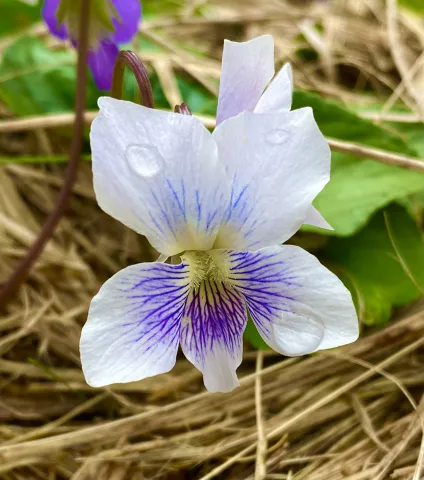Spring Violets

By Steve Roark
Volunteer, Cumberland Gap National Park
Violets are very abundant this time of year and are probably the most common and the easiest to identify family of spring wildflowers in our area. You can find them about anywhere, especially even in your yard right now unless you’re a grass purist who uses herbicides.
Wild violets typically have heart-shaped leaves that are blunt-toothed along the edge. The flowers of some species have petals that are “bearded,” having little hairs at the base of the petals, especially the lower ones. Violets in our area are mostly purple to blue, yellow, or white.
The blooms have five petals arranged so that two point upward and three down, with the lower middle petal sticking out a little longer than the others two to provide a landing zone for pollinating insects.
All wild violets have a “spur,” a blunt projection just behind the flower petals. Its proper name is nectar spur because it’s where nectar is produced. Putting this food source way back behind the flower means the pollinator insect (usually bees) has to really squirm deep into the flower to reach it, thus assuring it will get well coated with pollen and increasing the chance that it will pollinate another flower.
Here are some of the more frequent violets you’ll run across in our area:
The common blue violet (actually more a purple) is indeed very common, and can be found in yards, gardens, pastures and roadsides. It’s so frequently found close to home that it is also called “dooryard violet” and is considered by some to be a weed.
Another violet closely related to the common is the Confederate violet, so named for it grey-white/blue color combination that is reminiscent of the Confederate soldier uniform. Another common one found in grassy areas is field pansy, a small white violet with a yellow center. In the woods, you’ll likely run across the long-spurred violet, a pale purplish flower with a very long and narrow spur that sticks way out behind the back of the flower. Also in the woods you’ll likely run across the halberd-leaved violet, which is yellow, and cream violet, which is all white except for a few purple streaks in the center.
Violets are showy enough to be the state flower of four states, and are considered a symbol of love and faithfulness. Violets have had other uses besides being pretty, as the leaves are edible and high in vitamins A and C. They have been used in a salad, as a soup thicker, and a cooked green.
Warning: always properly identify an edible plant before trying it, and even then only try a small portion at first in case of food allergies.
The flowers have been candied by dipping them in sugar syrup. Violets have also been used as a medicinal by Native Americans and European settlers. The leaves were used as a blood purifier, and a leaf tea was used as a remedy for lung congestion and to treat a sore throat and cough. A poultice of leaves was used to treat small wounds and rashes.
- Log in to post comments